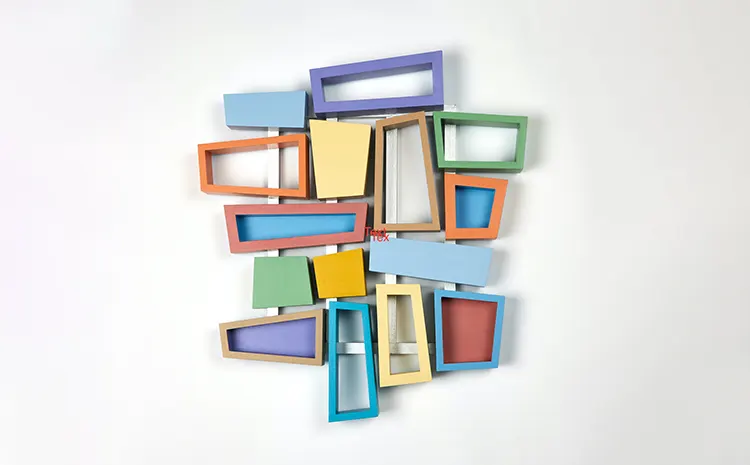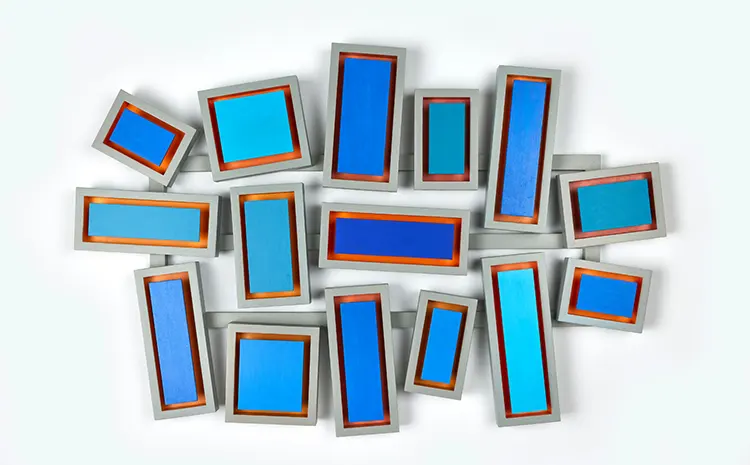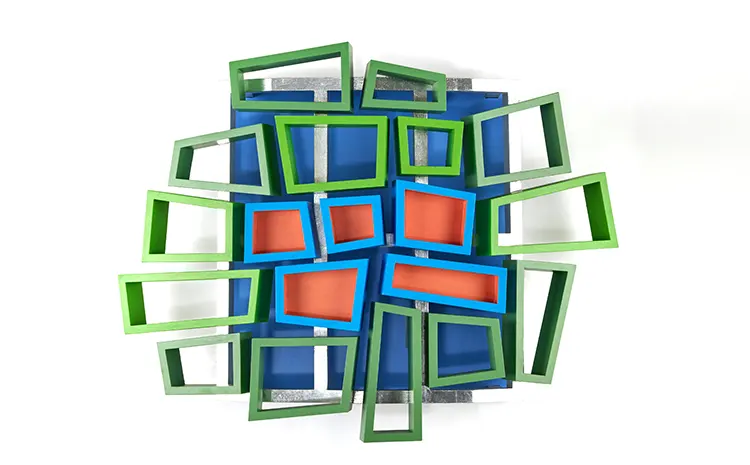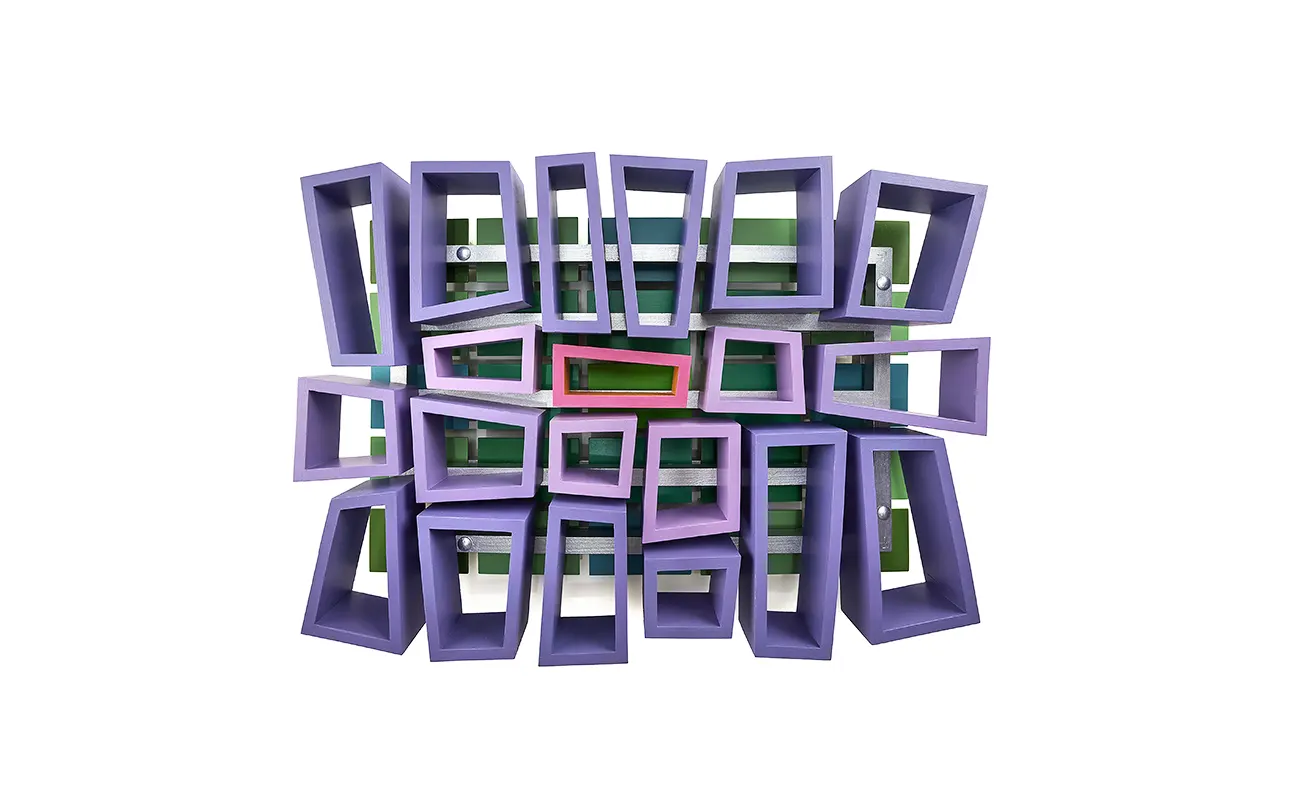“The content of my present works is entirely non-referential, and relies on geometric form to create intimate spaces that disconcert the viewer, and color to introduce mood and emotional influence.”
Born in Birmingham: Nurtured by Art and Craftsmanship
Born in Birmingham in 1940, Derek Morris was destined for the world of craftsmanship from his earliest years, embedded in a family deeply rooted in the arts and crafts. His father, a skilled craftsman, along with his mother, an accomplished embroiderer and weaver, and his sister, an adept jeweller and silversmith, played instrumental roles in shaping his aesthetic sensibilities.
The very world of creation that enraptured his familial surroundings also held Morris in its thrall, prompting a natural inclination towards artistic exploration. This inherent proclivity was further honed and nuanced through formal education at the University of Durham. Here, under the astute tutelage of Victor Pasmore and Richard Hamilton, he was exposed to the transformative, Bauhaus-influenced pedagogical approaches that revolutionized the field of art education.
This dynamic and stimulating educational environment catalyzed Morris’s intrinsic curiosity for processes and materials, facilitating a profound exploration of three-dimensional possibilities. It was during his second year of studies that he opted to specialize in sculpture, marking a pivotal moment in his artistic journey.
Upon graduation, Morris’s exceptional aptitude and creativity had earned him significant recognition, including a Hatton Scholarship and a First Class Honours Degree. His exemplary academic and artistic performance further presented an opportunity for an additional year of study, allowing him to delve deeper into his craft and continue refining his unique artistic vision.

Derek Morris: Bauhaus Influence and Sculptural Specialization
After earning his degree, Derek Morris graced the halls of his alma mater once more, this time in the capacity of an educator. This teaching phase spanned two enlightening years before he transitioned to the Norwich School of Art. At Norwich, his influence was pivotal in the creation of an esteemed Degree level Sculpture course. The course quickly ascended in both renown and appeal, establishing itself as a prime option for aspiring sculptors throughout the 1970s and 1980s. The year 1990 marked a turning point in Morris’s career when he decided to retire from pedagogy, opting instead to channel his full attention towards his art.
Morris’s artistic journey, marked by its evolution, was always in step with his fluctuating choice of materials. In the nascent stages of his career, his preference leaned towards carving or casting in resin. Gradually, he ventured into the realms of light and stainless steel, fostering a unique fascination for these elements. This fascination subsequently ushered him into an intensive exploration of ceramics, leading to the creation of intricate geometric forms.
In more recent years, Morris has made a significant shift in his artistic approach, with plywood becoming his primary medium. From this versatile material, he constructs vibrant reliefs intended for wall display, thereby introducing a fresh dynamic to his creative oeuvre.

Shifting Mediums: Exploring Steel, Ceramics, and Plywood
In 1999, Derek Morris received significant recognition in the field of sculpture with his esteemed appointment as the President of the Royal British Society of Sculptors. This notable position was held by him for a span of five years. Today, he continues to be a dynamic entity in the cultural sphere of Norwich, his dedication to the art of sculpture enduring and deep-seated, much like it was during his early years. His life, in essence, has been continually molded by this undying passion, making it the linchpin of his existence.
The inception of Morris’s fascination with abstract art can be traced back to his formative years, a time when he first uncovered the captivating world of Cubism. A majority of his oeuvre resides within this artistic genre, though it does not shy away from borrowing elements from the aesthetics of landscape composition and early Christian Church architecture. His contemporary creations are characterized by an absence of direct references, utilizing instead geometric forms to craft intimate spaces designed to unnerve the observer. The artist adeptly employs hues as a tool to infuse his work with emotional undertones and dictate the mood.
Morris conducts his creative endeavors across two distinct workshops. One caters to refined tasks and preliminary activities, including drawing and collage making. The other, on the other hand, is equipped with a vast workbench, an array of electrical equipment, and an assortment of tools – some of which are cherished heirlooms inherited from his father – for the purpose of practical creation. The artist’s inspiration draws from an eclectic mix, ranging from the Constructivists and Brancusi, to American Minimalists such as Don Judd. Nevertheless, his admiration is particularly reserved for Juan Gris, whose adept construction of paintings and masterful employment of color captivate him.

Derek Morris: From President of RBS to Creative Inspirations
Derek Morris produced a seminal piece entitled “Same Old Pink and Green 2020.” This unique work serves as a testament to his ingenious ability to expand the spatial dimensions against the canvas. The artist acknowledges the compositional equilibrium in the work and the astute employment of colour. Enhanced by a dose of witticism inherent in its name, this piece holds a special place amongst Morris’s oeuvre, resonating with him more profoundly than many of his other creations.
High-grade plywood has been a staple material in Morris’s artistic expression for an extended period, aligning impeccably with his pursuit of constructional lucidity. Throughout his illustrious career, he has explored the use of various materials – wood, stone, resin, stainless steel, jesmonite, light, and perspex – each contributing to the unique aesthetic appeal of his works. His palette is brought to life through the use of superior quality acrylic paints.
An unfulfilled ambition lies within the heart of this artist – the aspiration to transpose one of his reliefs into a grander exhibit, destined for display upon an unadorned wall. His artistic journey continues, each stroke, each chisel bringing him closer to this cherished vision.






